The most important single thing is to focus obsessively on the customer. Our goal is to be earth’s most customer-centric company.
—Jeff Bezos
Customer Centricity
Customers are the ultimate beneficiaries of the value of the business solutions created and maintained by the portfolio value streams. Customer centricity is a mindset and a way of doing business that focuses on creating positive experiences for the customer through the full set of products and services that the enterprise offers.Customer-centric businesses generate greater profits, increased employee engagement, and more satisfied customers. Customer-centric governments and nonprofits create the resiliency, sustainability, and alignment needed to fulfill their mission. All customer-centric enterprises deliver whole-product solutions that are designed with a deep understanding of customer needs.
Note: This article focuses on the mindset and impact of customer centricity. It should be read with the Design Thinking article, which focuses on the tools and practices of implementing design thinking in support of customer centricity.
Details
Customer centricity is a mindset: Whenever a customer-centric enterprise makes a decision, it deeply considers the effect it will have on its end users. This motivates us to:
- Focus on the customer – Customer-centric enterprises use segmentation to align and focus the enterprise on specific, targeted user segments
- Understand the customer’s needs – Customer-centric enterprises move beyond merely listening to customers who ask for features. Instead, they invest the time to identify underlying and ongoing customer needs
- Think and feel like the customer – Customer-centric enterprises try to see the world from their customer’s point of view
- Build whole product solutions – Customer-centric enterprises design a complete solution for the user’s needs, ensuring that the initial and long-term experience of the customer is always ideal and evolving as needed
- Know customer lifetime value – Customer-centric enterprises move beyond a transactional mentality and instead focus on creating longer term relationships based on a clear and accurate understanding of how the customer derives value from the solution
Research Driven
The foundation of the customer-centric enterprise is market and user research that creates actionable insights into the problems customers face, the solution requirements, and the solution context. Market research tends to drive strategy; user research tends to drive design, as highlighted in Figure 1 below.
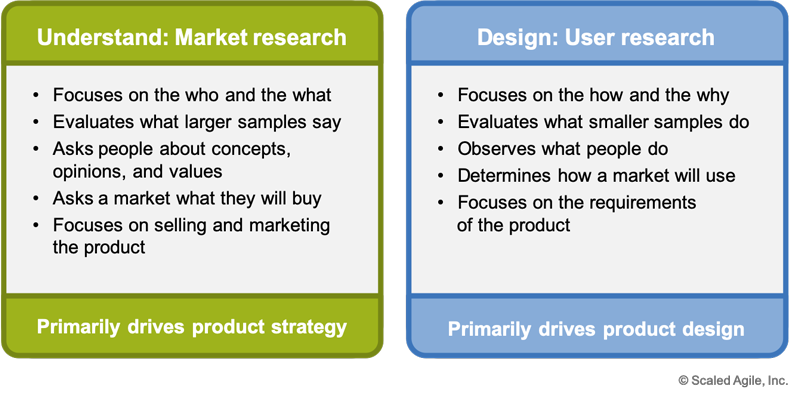
Research activities occur continuously and are directly supported through Continuous Exploration in the Continuous Delivery Pipeline, product telemetry data, and the feedback loops that exist between the solution and the Solution Context.
Design with Empathy
Customer-centric enterprises apply empathic design throughout the design process. Empathic design refers to our ability to put aside our preconceived ideas and develop solutions from the perspective of our customers. [1]
Empathic design motivates teams to understand and experience the world from the customer’s perspective, learning and appreciating the difficulties they face, their roles, and their work context. It emphasizes user research, including activities such as Gemba walks (visiting the place where the customer work is done). Gemba builds empathy by helping agile teams to gain a deeper understanding of the user’s emotional and physical needs—the way they see, understand and interact with the world around them.
Empathic design guides the development of solutions that move beyond functional needs, also addressing:
- Aesthetic and emotional needs
- Ergonomic needs, such as the placement of physical features
- Product attributes that may not be explicitly requested by users, such as performance, security and compliance, but which are essential for viability
- An understanding of how the solution may impact the solution context
- The impact of the solution on related or affected groups
- That the architecture of the solution ensures that operations, maintenance, and support account for the needs of the customer
Degrees of Customer Engagement
Market research helps us determine the nature of the relationship we create with our customers. This is largely determined by whether the solution is a:
- General solution – intended to be used by a significant number of customers
- Custom-built solution – built and designed for an individual customer
Figure 2 illustrates the relative level of indirect or direct customer engagement in each case
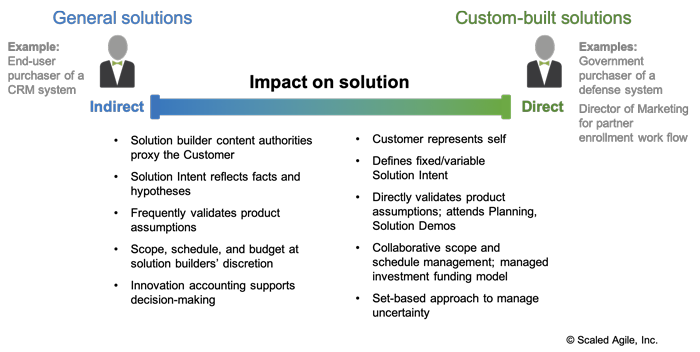
General Solutions
General solutions must address the needs of a broader market or segment in which no single customer adequately represents the whole market. In this case, Product and Solution Management become the indirect customer proxy; they have authority over solution content. It’s their responsibility to facilitate external interaction and make sure that the “voice of the customer” will be heard, and that the organization will continuously validate new ideas. Scope, schedule, and budget for development are generally at the discretion of the internal Business Owners.
Since it’s unlikely that any customer will participate regularly in planning and system demo sessions, customer interaction is typically based on requirements workshops, focus groups, usability testing, and limited beta releases. To validate various hypotheses, the solution evolves through feedback from user behavior analysis, metrics, and business intelligence.
Custom-Built Solutions
For custom-built solutions, external customers collaborate with Product and Solution Management in joint design efforts. While the customer is leading the effort, deliverables, sequencing, and timing are negotiated. This promotes incremental learning and creates opportunities to adjust plans based on the best available data.
SAFe’s focus on cadence-based development directly supports the collaborations that create the best outcomes in custom-built solutions. For example, PI Planning provides the time and space to align all stakeholders around the next set of deliverables. The successful completion of the Program Increment establishes a high degree of trust in the joint development process and generates data that improves forecasting and economic modeling.
Deep and Narrow Solutions
In the zone between general solutions and custom solutions are deep and narrow solutions. A deep and narrow solution has a small number of customers that will often pay a significant amount of money for these products and services. For example, a solution to manage logistics for stadiums of more than 50,000 seats will serve a total potential market of less than 400 total customers.
While maintaining the discipline of creating a single solution that answers a target’s market needs, these Product and Solution Managers must leverage their familiarity with the small number of customers they’re serving.
Multi-Segment Solutions
Some solutions serve disparate market segments in which each segment uses the solution in slightly different ways. In this situation, customer centricity means understanding the unique needs of each segment even if the solution serves multiple segments.
For example, a B2C software company serving hundreds of thousands to millions of indirect customers via a website may also offer a set of developer APIs to partners. Members of this B2B partner segment may act more like customers of custom-built solutions, each making specific requests of the software provider to adjust, extend, or improve the API to better meet their unique needs. The goals of customer-centricity in this kind of solution is to understand the needs of both the B2C and B2B segments and establish a roadmap that continues to serve each.
Whole Product Thinking
Customers never purchase a “generic” solution like a dishwasher or hotel room. Rather, they buy a specific product from a specific vendor. It’s the design of this solution that determines the degree of perceived and actual value; i.e., how effectively this solution meets the customer’s total needs.
Whole Product Thinking [4] helps ensure that the products and solutions being created for customers fulfill their needs (Figure 3):
- The generic product is often considered the “minimal offering” of a product. For a dishwasher, that would be the ability to wash dishes and nothing more. For a hotel, it might be a clean room and little else.
- The expected product represents the customer’s minimal purchase conditions as informed by alternative or competing products. For example, a dishwasher without different cycles or a timed delay start may not meet current market expectations.
- The augmented product goes beyond what is expected and enables competitors to differentiate their offerings. A dishwasher that provides a mobile phone app to signal when the washing cycle has completed may qualify.
- The potential product represents everything that might be done to attract and keep customers. Informed by research, it fuels longer-term strategic planning and creates opportunities for sustainable product advantages.
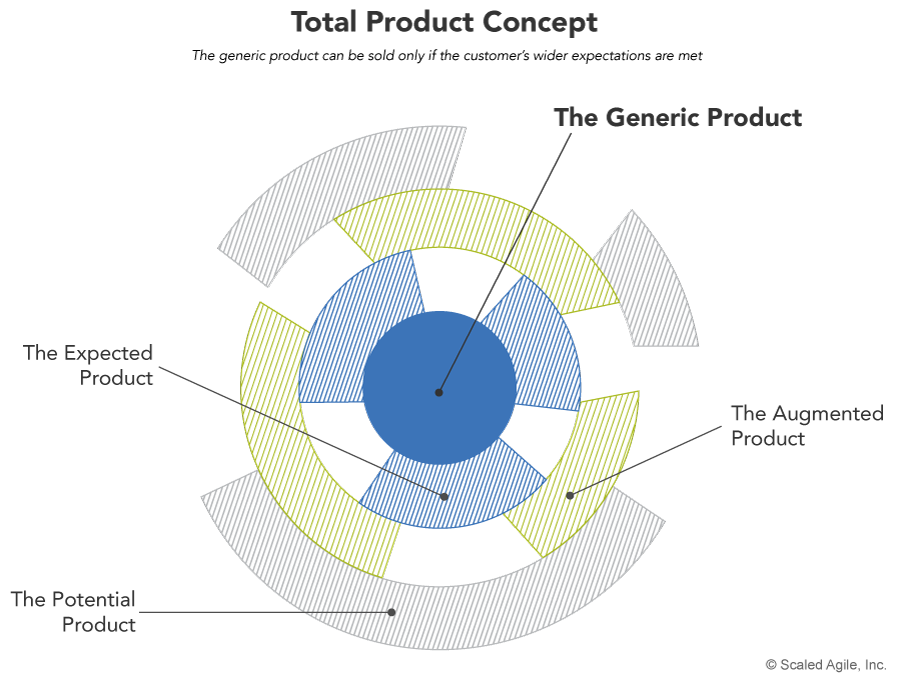
Leveraging Market Rhythms and Events
The Lean-Agile Mindset that drives the continuous and sustainable flow of value to customers motivates the customer-centric organization to understand how timing of specific releases influences their perceived value. Simply put, the value of a release can vary significantly based on when it is released.
To create the highest value for all stakeholders, customer-centric organizations leverage market rhythms and market events: [3]
- A market rhythm is a set of events that occur repeatedly on a predictable cadence. For example, retailers routinely prepare for the holiday shopping season by upgrading their systems to gain a competitive edge to support significantly higher transaction volumes.
- A market event is a one-time future event, which has a high probability of materially affecting one or more solutions. They can be external, such as the launch of government regulations, or they can be internally created, such as a company’s annual user conference.
Understanding Market Rhythms
Market rhythms help companies recognize and capitalize on opportunities that are predictable and require longer-term planning.
Figure 4 illustrates an example of the market rhythms of three different companies. The vertical axis shows the value delivered to a market, while the horizontal axis depicts the value over time, usually a calendar or fiscal year. The green line in Figure 4 represents a social media company where the value over time is relatively constant, which suggests it is less affected by market rhythms [3].
The next two examples in Figure 4 show more typical market rhythms for companies that must get their products ready for release responding to a well-known rhythm. A B2B software provider who markets real-time pricing software updates must issue important alerts well in advance of the shopping season. (Imagine updating every point of sale terminal in 400 different stores – and training all employees on the new capabilities!) Similarly, the “hot new toy” of the Holiday shopping season won’t seem so hot or new in January!
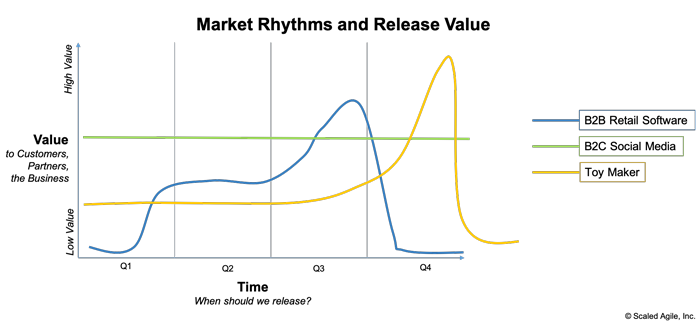
Capturing Market Events
Armed with the understanding of market rhythms, customer-centric road-mapping activities typically focus on the impact of market events. In Figure 5, we show three common events: the release of new regulations, expected moves of a competitor, and technology changes and upgrades.
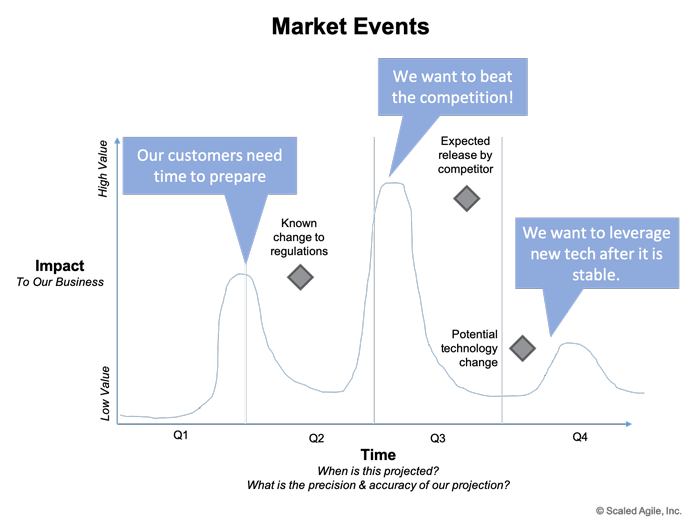
Market events are typically represented as milestones, and they strongly impact the timing for releasing solutions. They may also inform the content and timing of features or solution development activities identified during Program Increment (PI) planning.
Understanding the Solution Context
Insights gained from the Gemba walks and other research activities define the functional and operational requirements of the solution’s operating environment. In SAFe, this is known as the Solution Context, which captures environmental, installation, operation, and support requirements.
Understanding Solution Context is crucial to value delivery. It identifies constraints outside the organization’s control. As examples, consider the icy roads that a self-driving vehicle must navigate, or the regulations with which it must comply. Solution Context also describes the negotiated constraints, such as when the organization uses principles of set-based design and collaborates with one or more Suppliers to optimize the total system’s space, power requirements, and weight.
Accordingly, some aspects of Solution Context are fixed, and some are negotiable; this creates a level of coupling between the Solution, Suppliers, and the Solution Context. The mandate of Business Agility motivates Product and Solution Managers to seek optimal solutions, including changing the Solution Context to encourage innovation.
Understanding Customer Value
Creating viable and sustainable offerings requires a deep understanding of the customer’s perception of value. Consider a for-profit enterprise that has identified a customer problem that will cost them $800K to solve. If the customer perceives less than $800K in value from the solution, the organization will be unable to sell it at a price that creates a viable offering. And even if the customer perceives more than $800K in value, suggesting the enterprise can make a profit, the solution may not be sustainable if the revenue is insufficient to fund new and ongoing work.
There are two primary means by which a customer derives value from products and solutions, 1) reducing their costs and 2) increasing their revenue (Table 1).
| Cost Reduction | Revenue Enhancement |
| Is less expensive to purchase | Accelerates their time-to-market |
| Lowers operational costs | Creates access to new markets |
| Streamlines workflows | Creates new product offerings |
| Reduces labor costs | Creates opportunities for service revenue |
| Reduces compliance costs |
Table 1. Elements of customer value
There are a number of other aspects of value as well. Secondary aspects of value derivation include such things as brand value, and the alignment of values between the customer and the enterprise [3].
Learn More
[1] Leonard, Dorothy, and Jeffrey F. Rayport. Spark Innovation Through Empathic Design. Harvard Business Review, December 1997. [2] Moore, Geoffrey. Escape Velocity: Free Your Company’s Future from the Pull of the Past. Harper Business, 2011. [3] Hohmann, Luke. Beyond Software Architecture: Creating and Sustaining Winning Solutions. Addison-Wesley Professional, 2003. [4] Levitt, Theodore. Marketing Success Through Differentiation—of Anything. Harvard Business Review, January, 1980.
Last update: 10 February 2021


